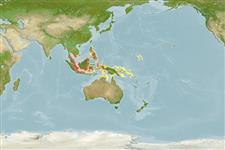Common names from other countries
Environment: milieu / climate zone / depth range / distribution range
Ecologie
Rifbewoner. Tropical
Western Central Pacific: throughout Southeast Asia, reaching the Philippines.
Length at first maturity / Size / Gewicht / Leeftijd
Maturity: Lm ? range ? - ? cm Max length : 10.0 cm CW mannelijk/geslacht niet bekend; (Ref. )
Carapace ovate, covered with numerous very small granules; regions well defined; 4 broad lobiform teeth on each anterolateral margin. Eyes green in life. A larger molariform tooth at base of movable finger of larger chela. Carapace dirty-brown overall; eyes green, fingers black.
Occurs from shallow water to intertidal zones. Inhabits mangrove areas and prefers rocky areas, or areas densely covered by bivalves, such as Perna spp. Benthic. Tropical climate (Ref. 343).
Life cycle and mating behavior
Geslachtsrijpheid | Voortplanting | Kuitschieten | Eieren | Fecundity | Larven
Members of the order Decapoda are mostly gonochoric. Mating behavior: Precopulatory courtship ritual is common (through olfactory and tactile cues); usually indirect sperm transfer.
Ng, P.K.L. 1998. (Ref. 343)
Status op de Rode Lijst van het IUCN (Ref. 130435)
Status bij CITES (Ref. 108899)
Not Evaluated
Not Evaluated
Gevaarlijk voor mensen
Harmless
Gebruik door de mens
| FishSource |
Tools
Meer informatie
Leeftijd/GrootteGroeiLengte-gewicht parametersLengte-lengte parametersMorfologieLarvenAbundantie
Internet-bronnen
Estimates based on models
Kwetsbaarheid
Low vulnerability (10 of 100).
Prijsklasse
Unknown.
